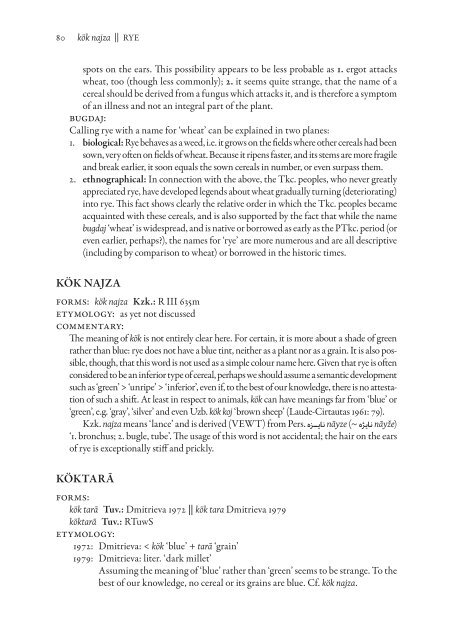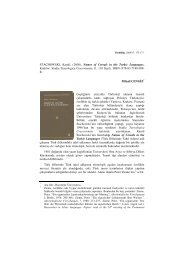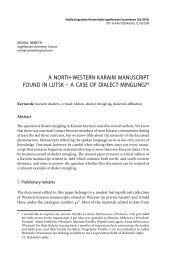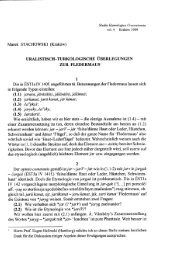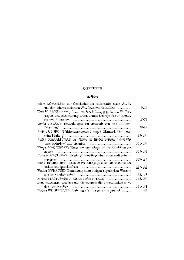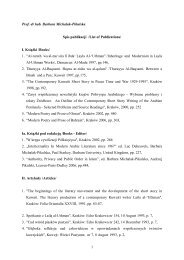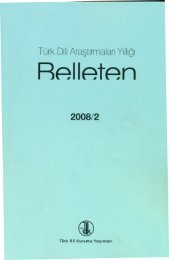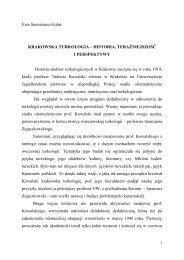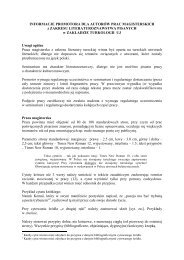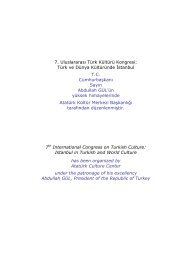Names of Cereals in the Turkic Languages - Wydział Filologiczny UJ
Names of Cereals in the Turkic Languages - Wydział Filologiczny UJ
Names of Cereals in the Turkic Languages - Wydział Filologiczny UJ
- No tags were found...
Create successful ePaper yourself
Turn your PDF publications into a flip-book with our unique Google optimized e-Paper software.
80 kök najza || Ryespots on <strong>the</strong> ears. This possibility appears to be less probable as 1. ergot attackswheat, too (though less commonly); 2. it seems quite strange, that <strong>the</strong> name <strong>of</strong> acereal should be derived from a fungus which attacks it, and is <strong>the</strong>refore a symptom<strong>of</strong> an illness and not an <strong>in</strong>tegral part <strong>of</strong> <strong>the</strong> plant.bugdaj:Call<strong>in</strong>g rye with a name for ‘wheat’ can be expla<strong>in</strong>ed <strong>in</strong> two planes:1. biological: Rye behaves as a weed, i.e. it grows on <strong>the</strong> fields where o<strong>the</strong>r cereals had beensown, very <strong>of</strong>ten on fields <strong>of</strong> wheat. Because it ripens faster, and its stems are more fragileand break earlier, it soon equals <strong>the</strong> sown cereals <strong>in</strong> number, or even surpass <strong>the</strong>m.2. ethnographical: In connection with <strong>the</strong> above, <strong>the</strong> Tkc. peoples, who never greatlyappreciated rye, have developed legends about wheat gradually turn<strong>in</strong>g (deteriorat<strong>in</strong>g)<strong>in</strong>to rye. This fact shows clearly <strong>the</strong> relative order <strong>in</strong> which <strong>the</strong> Tkc. peoples becameacqua<strong>in</strong>ted with <strong>the</strong>se cereals, and is also supported by <strong>the</strong> fact that while <strong>the</strong> namebugdaj ‘wheat’ is widespread, and is native or borrowed as early as <strong>the</strong> PTkc. period (oreven earlier, perhaps?), <strong>the</strong> names for ‘rye’ are more numerous and are all descriptive(<strong>in</strong>clud<strong>in</strong>g by comparison to wheat) or borrowed <strong>in</strong> <strong>the</strong> historic times.kök najzaforms: kök najza Kzk.: R III 635metymology: as yet not discussedcommentary:The mean<strong>in</strong>g <strong>of</strong> kök is not entirely clear here. For certa<strong>in</strong>, it is more about a shade <strong>of</strong> greenra<strong>the</strong>r than blue: rye does not have a blue t<strong>in</strong>t, nei<strong>the</strong>r as a plant nor as a gra<strong>in</strong>. It is also possible,though, that this word is not used as a simple colour name here. Given that rye is <strong>of</strong>tenconsidered to be an <strong>in</strong>ferior type <strong>of</strong> cereal, perhaps we should assume a semantic developmentsuch as ‘green’ > ‘unripe’ > ‘<strong>in</strong>ferior’, even if, to <strong>the</strong> best <strong>of</strong> our knowledge, <strong>the</strong>re is no attestation<strong>of</strong> such a shift. At least <strong>in</strong> respect to animals, kök can have mean<strong>in</strong>gs far from ‘blue’ or‘green’, e.g. ‘gray’, ‘silver’ and even Uzb. kök koj ‘brown sheep’ (Laude-Cirtautas 1961: 79).Kzk. najza means ‘lance’ and is derived (VEWT) from Pers. نايزه nāyze (~ نايژه nāyže)‘1. bronchus; 2. bugle, tube’. The usage <strong>of</strong> this word is not accidental; <strong>the</strong> hair on <strong>the</strong> ears<strong>of</strong> rye is exceptionally stiff and prickly.köktarāforms:kök tarā Tuv.: Dmitrieva 1972 || kök tara Dmitrieva 1979köktarā Tuv.: RTuwSetymology:1972: Dmitrieva: < kök ‘blue’ + tarā ‘gra<strong>in</strong>’1979: Dmitrieva: liter. ‘dark millet’Assum<strong>in</strong>g <strong>the</strong> mean<strong>in</strong>g <strong>of</strong> ‘blue’ ra<strong>the</strong>r than ‘green’ seems to be strange. To <strong>the</strong>best <strong>of</strong> our knowledge, no cereal or its gra<strong>in</strong>s are blue. Cf. kök najza.


